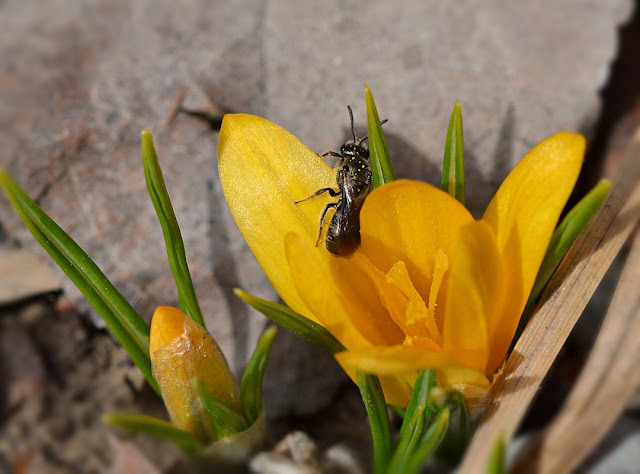NOTE: I originally started a post showcasing the first bees on the first flowers- wild Aspen and Willow catkins, then the earliest flowers in the garden. Since I hadn't finished that one, and wanted to move on to May Day/Ūsiņš, I decided to combine them, since Ūsiņš is associated with bees in Latvia, and this year's post was going to be mainly about bees anyway, so-more photos in this post, even an extra title photo, since I already had the first one ready!
Another Cross-quarter day has come around- the actual date May 04, this year. As usual, there are various traditional celebrations orbiting this date, fixed at one day or another for calendrical and/or religious accommodation reasons (e.g. to align with Christian Saint Days). So we have Beltane, the Celtic beginning of Summer and May Day both typically observed on May 01. In the Latvian tradition we have Ūsiņš Day which should be placed on the Cross-quarter day but has been conflated with Jurģi/ Christian Saint George Day on April 23. I look at possible origins, and speculate on (invent?) a possible partnership with Ziedu Māte/Flower Mother in this post: Ūsiņš Day
In all cases, these are celebrations of greening and florescence, of moving into the richness of life in summer, of agrarian seasonal schedules (e.g. traditonally Latvians change horses' pasturing at this time). The Latvian tradition divides the year into seasons, and Ūsiņš Day marks the beginning of the Time of Flowers- while I'd hesitate to say summer is truly beginning here, flowers are appearing daily in my gardens and just beginning now in the wild (including the catkins of poplars and willows, we can extend that season back a few weeks). Ūsiņš is also associated with bees, certainly an important part of spring and flowering season! Honeybees make an early appearance here, visiting poplars and willows, and native bees and other pollinators begin to show up as more willows open flowers and things pop up in the rock and woodland gardens.
 |
| Bees get all the glory, but many flies are important pollinators |
Early spring here is a time of melting, thawing, a slow awakening. Now we celebrate the next stage as flowers and buzzing life return, the creeping green that begins in sunny or watery spots slowly spreads and soon the trees will burst forth a new season's leaves!
 |
| Even the very first scattered willows to open flowers manage to attract honeybees! |
Wishing you a Beautiful Time of Flowers, and (belatedly now, but I think the season still applies!) Blessed Ūsiņš Day, Happy May Day, Blessed Beltane- may your summer be bountiful. (And a Beautiful Autumn to those on the opposite side of the Sun's path!)
Now: some videos and more photos!
Videos, recorded from April 14 to May 08 Bees on catkins and garden flowers.
The initial videos are hosted on YouTube. At the end of the post I will include links to Spectra which is part of the Fediverse, operating on Peertube which is a decentralised and non-corporate video hosting service for those who prefer such things! (like Mastodon etc- feel free to ask me if you want to know what that's all about). The videos are the same, though the Spectra version is usually a smaller file size.
1-Spring has Sprung: Buzzy Bees Fuzzy Flowers!
2-Happy Bees, Hangry Cow? Bees on Aspens
3-Bees + Pussywillows! That's Spring
4-Itsy Bitsy Bees on Spring Flowers + Honeybees on Pussywillows
5-Bees and Flowers! Spring Rock Garden
Comments on the ease of reading on this platform are welcome. I'm also starting to experiment with Wordpress. You can find me on
If you are able and would like to support me, I have a Ko-fi page; support helps me keep working-more research, more writing, more art!
(see this post for musings on support sites: https://cohanmagazine.blogspot.com/2021/01/fiction-feedback-and-finances.html ).
As usual, if you love an image, it could be loaded to any of the print on demand sites as cards, prints, mugs, clothing etc. Haven't played with any of those for a while, hope to get back at them soon.
Now, those Spectra video links I promised:








Comments
Post a Comment